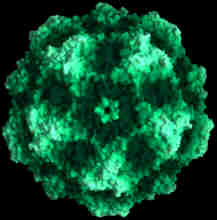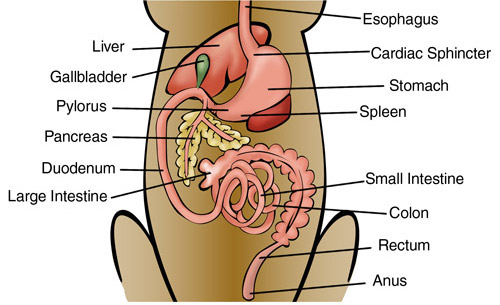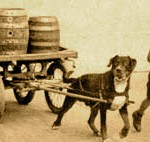Parvovirus is a devastating and deadly diseased affecting mostly puppies. I have compiled my limited medical knowledge and the research I have done to treat and protect my own dogs so that it may hopefully help someone else.
In order to understand Parvovirus specifically, it is important to have basic knowledge of virus in general.
Viruses are tiny, microscopic organisms smaller even than bacteria. They are so basic that they are barely life forms. They rely completely on their host cell, unable to grow or reproduce without it. After a virus invades a living cell, it sets about replicating itself sometimes at an astonishing rate, and then changes how the cell functions. Some viruses also have the ability to mutate, which makes treatment even more difficult.
Parvovirus is even smaller than most viruses and consists of only a single strand of DNA and a protein coating. It is difficult to believe that something so simple could be so devastating. The original Canine Parvovirus (CPV-1) was discovered in 1967, and was really only a threat to newborn puppies. Another strain appeared in the United States in 1978, CPV-2. When the virus debuted in 1978, no dog of any age had any immunity and the epidemic was devastating. To make things worse, in 1979, a second mutation, CPV-2a, and even more aggressive strain occurred. Vaccines were at a premium, and some vets resorted to making a version of the Feline Distemper vaccination, as the two are considered closely related.
Although Canine Parvovirus has only been around since 1967, most mammal species has its own Parvovirus, including humans. Most forms of Parvovirus remain species specific (human Parvo infects only humans, pig parvovirus infects only pigs, etc.) however, in 2000, CPV-2c was discovered and has the ability to affects cats. However, cats vaccinated against Feline distemper were considered protected. The most common canine Parvovirus is currently CPV-2b and affects only the canine family (wolves, foxes, coyotes, etc.).
Parvovirus has been around for about 40 years. It is a very hardy virus that is difficult to disinfect and it is shed in MASSIVE quantities by infected dogs for about two weeks following intestinal infection. It can be spread by direct contact, but does not require it. It can be spread indirectly as well by shoes, clothes, car tires, other animals, etc. Because of this, it is virtually everywhere–stores, parks, floors, carpet and yards. And because it is such a hardy virus, once shed, it can live in the environment for more than six months and is protected rather than harmed by freezing temperatures. Just like with human viruses, not everyone infected is properly quarantined, and some dogs will be asymptomatic or not showing obvious signs, so this spreads even more of it around. Add to this how incredibly contagious it is–there is potentially enough of the virus in once ounce of infected stool to infect over 35,000 dogs–and it is no wonder Parvovirus is so widespread. At this time, Parvovirus is considered to be ubiquitous, or present in EVERY environment unless regularly disinfected. Because of the pervasiveness of Canine Parvovirus, virtually every dogs is considered to have been exposed, even those that were not properly vaccinated. Thus, all adults dogs are considered to have some degree of immunity. This is why Parvo is considered deadly mostly for puppies and youth dogs.
Canine Parvovirus is horrible, cruel and heartless disease that does not care about the size or apparent health of a victim. It strikes hard and viciously and without mercy. So what determines who will get it, and who will survive? Whether or not infection occurs depends mostly on 3 factors
• Host Vitality (including vaccination status and immune experience)
• Virulence of the Virus (how many “viral particles” the host is exposed to)
• Environment (any number of factors affecting either the host or virus–i.e. a stressful environment for the host will decrease host (puppy) vitality; or a “cleaner” or dryer environment will decrease the virulence of the virus.).
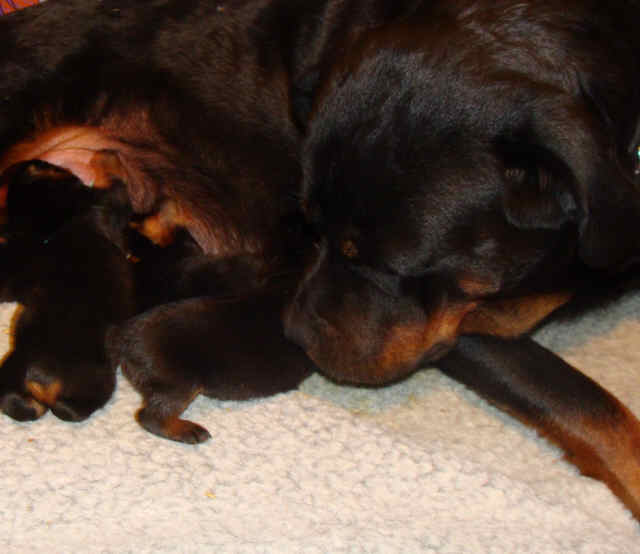
So what makes puppies so vulnerable?
When a puppy is first born, it lacks the ability to make any antibodies of any kind, obviously making it extremely vulnerable to a myriad of diseases. However, Heavenly Father had provided for this with the miracle of mother’s first milk. The first 2 days after birth, the mother will produce a very special milk called colostrum. This colostrum contains all the antibodies that the mother had been exposed to. This is why it is so vital for the pups to receive mom’s milk for at least the first 2-3 days. The amount of antibodies each individual pup will receive varies depending of it’s order of birth, and how much colostrum it consumed. The amount of antibodies is also affected by the mother–how much exposure she has had; her vaccination history. If she was vaccinated around the time of conception, her antibody will be at a higher level. Not every puppy will receive the same number of antibodies. Every 9 days the number of antibodies the newborn pups have will decrease by half, until they no longer contain a sufficient amount to fight off a virus. As explained previously, the exact time it takes a puppy to reach this point varies per individual puppy. If the vaccination is given too early, it has no effect on the puppy as the mother’s antibodies will bind with the virus and not give the puppy’s body the opportunity to begin production of its own antibodies. However, if given too late, then the puppy has a longer window of susceptibility. For this reason vaccinations are given in a series. Not because the puppy needs a certain number of vaccinations, but because it is impossible to tell at exactly what date the puppy will respond to the given vaccination.
UPON ENTERING YOUR PUPPY
We have discussed the mode of infection for parvovirus, so what happens once the dog is infected and why is it so deadly?
Parvovirus is shed in the feces of infected dogs, and this is mainly how it is transmitted. Another dog comes into contact with even the smallest trace amount either directly or indirectly and ingests it. Puppies especially, just like a baby, will pick up anything in their mouth. The dog could step in it or sit in it and then lick himself; he could drink water from a puddle that has been contaminated or even a water bowl.
Once the puppy has ingested the Parvovirus, there is a 3-7 day incubation period before the puppy begins to feel sick.
Upon entering the dogs body, the virus will look for the closest place of rapidly dividing cells–the lymph nodes in the throat. Here the virus will replicate itself rapidly for a couple of days until a significant amount has been released into the bloodstream. Over the next 3-4 days, the virus will seek out new organs where rapidly dividing cells are located–the puppies bone marrow and the Gastrointestinal or GI tract.
Once in the bone marrow, the virus will destroy the white blood cells responsible for the dogs immune system. This depletes the puppy’s ability to fight parvo or any other virus as well as any possible infection.
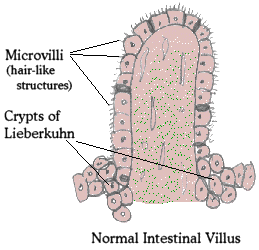
The GI tract is lined with tiny finger like protrusions called villi. These villa increase the surface area of the intestine to allow easy absorption of fluid and nutrients from what the puppy consumes. The villi are also lined with another layer called microvilli. The microvilla are very short lived cells and replaced constantly with new microvilli cells located at the base of the villa in what is called the Crypts of Lieberkuhn. Right here, in these crypts is where the parvovirus strikes. The rapidly dividing cells provide the perfect place for it to begin replicating itself. Without new microvilli, the villa is rendered ineffective prohibiting the puppy from absorbing any nutrients for the food with results in severe diarrhea and, heavy cramping of the abdomen and nausea. The barrier separating the digestive bacteria in the GI tract from the bloodstream breaks down causing the blood to enter the GI tract (resulting the the hallmark bloody diarrhea) but more devastatingly, causing the bacteria to enter the bloodstream where it is then carried throughout the body resulting in widespread infection that the puppy has no defense against as the white blood cells (the puppy’s immune system) were damaged as well.
So death occurs for two primary reasons:
* The diarrhea and vomiting cause severe dehydration resulting in shock and death.
* The puppy dies from septic infection resulting from the bacteria that have entered the bloodstream.
Both methods are equally deadly and result in suffering.
How can a puppy survive such a tragic disease?
Parvovirus is just like any other virus and must run it’s course. The puppy’s survival becomes a race between its body’s ability to recover and the damaged immune system to repair itself versus the loss of fluids and invasion of bacteria. Everyday the puppy survives, his body is able to make more antibodies.
DIAGNOSIS AND TREATMENT.
Early intervention is the most important part of the equation. In a young puppy, ALWAYS assume parvo if there is vomiting, diarrhea and lethargy. The earlier you begin treatment, the greater the puppy’s change of survival.
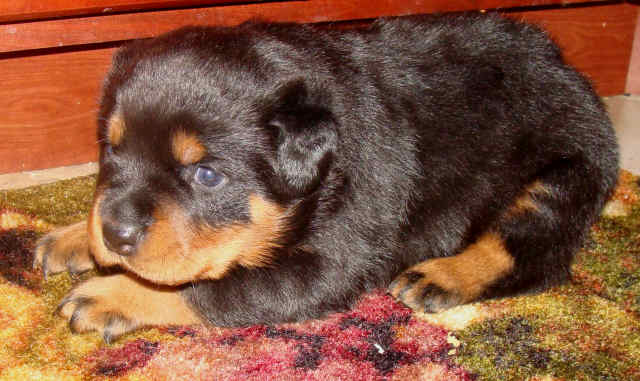
If your puppy has diarrhea, vomiting or lethargy, ESPECIALLY if there is blood in the stool, immediately take your puppy to the vet and have a snap test for Parvovirus performed. This test only takes about 15 minutes, so you can begin treatment immediately. Most vets will realize the urgency if parvo is suspected, but in case your vet wants to do a fecal float (a test sent out that can take 48 hours to return!) insist on a Parvo snap test or take your puppy somewhere else. In 48 hours, if it is parvo and you have not begun treatment, you puppy will be dead.
It should be noted that if the puppy was recently vaccinated with a live or modified live virus for parvo (SEE LIVE vs. KILLED VACCINATION further down on the page) it could produce a false positive. If you are unsure, have a CBC performed. This is where blood is drawn and a Complete Blood Count (CBC) is made which will let you know how many white blood cells your puppy has. Remember that Parvo attacks the bone marrow depleting the white blood cells. So a severely depleted white cell count in conjunction with the parvo symptoms and a positive snap test most assuredly denotes parvo.
Once you have your diagnosis, the best solution for your puppy is to be hospitalized in the vet’s office or animal hospital. Here your puppy can receive vital IV fluids, antibiotics to help combat the bacterial infection, and important monitoring. You must accept that a positive diagnosis for Parvo will mean a very expensive vet bill with a vet stay of 5 days or more which could still prove ultimately futile. Parvo hits breeds such as the Rottweiler and doberman pincher harder and responds poorly to treatment in these breeds. However, with hospitalization, early detection and proper treatment, your puppy faces much better odds. Left untreated, Parvo has nearly a 100% death rate among Rottweilers.
PLEASE BE ADVISED THAT THE FOLLOWING IS DISPENSED AS USEFUL INFORMATION ONLY AND SHOULD NOT BE USED IN PLACE OF VETERINARY CARE. YOUR PUPPY’S BEST CHANCE FOR SURVIVAL IS TO BE ADMITTED INTO THE HOSPITAL.
If your financial situation prevents hospitalization, and you have no other alternative but to home treat, here are some steps that MUST be taken:

If you have the ability and access, IV fluid is your best option. You must replace the fluid lost from the vomiting and diarrhea or the puppy’s body will shut down.
If you are not able to give the puppy any IV, your next best option is subcutaneous fluid replacement. You can obtain bags of IV fluid solution and equipment necessary from your vet. Some vets will even talk you through “how to.” Basically, you want to get the puppy by the scruff of the neck, and pull that skin up making a pocket to insert the needle. When done correctly, your puppy will barely feel it, so do not worry about sticking the needle into the skin. Once you have the needle in place, simply open the line and allow the fluid to enter subcutaneously, or under the puppy’s skin. Do not be alarmed if a “hump” of fluid forms. This is what is expected. When you withdraw the line, the puppy’s body will gradually absorb the fluid. Once it has, then you can administer more. Intravenously is by far the preferred method as it is absorbed directly into the bloodstream and able to benefit the puppy immediately, but Subcutaneously is far better than allowing dehydration to shut the puppy’s organs down and put it into shock. Here are some video’s that I found on You Tube that explain the process of setting up the line and administering the fluid very well.
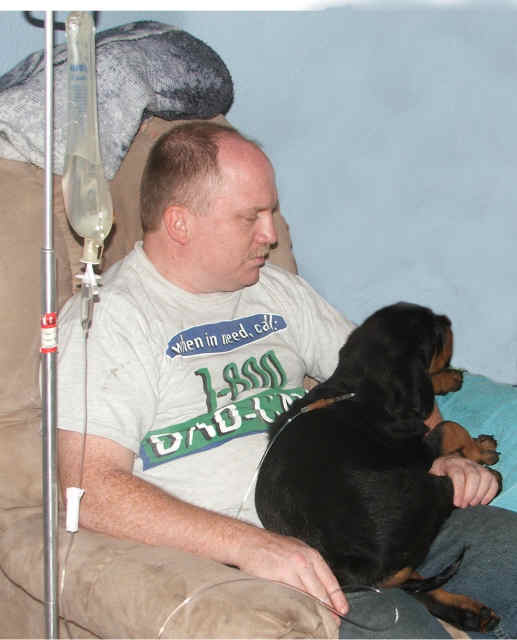
Setting up the I.V. Bag
Giving Subcutaneous Fluids
Sub Q Fluids
*NOTE: Most of the Videos were of cats because felines have a higher propensity towards dehydrative issues such as kidney/renal failure, blocked urethra, etc. Our own cat, Malakai, had to have surgeries for crystalline build-up leading to a blocked urethra and eventually a burst bladder. But the method is the same for your puppy.
The next most important issue to tackle with parvo is combating infection. As mentioned, parvo depletes you puppy’s ability to fight infection from invading bacteria, so antibiotics are essential. You may also get a prescription for this from your vet. Again, IV injection is the preferred method as most everything administered orally will be thrown up, but oral administration is preferred to no administration. There are several antibiotic choices and different vets have different preferences. The important point is to give antibiotics.
The next issue is to control (or attempt to control) the vomiting. Metoclopramide works well as does Chlorpromazine. An added benefit of Chlorpromazine is that it also promotes drowsiness, this way your little guy can sleep through most of the discomfort and give his body the extra rest it needs. Again, when administered via constant drip through an IV, Metoclopramide will have a more continuous effect, compared to administered every 6-8 hours with a period of decreased effectiveness.
Also of special note is a drug called Tamiflu, available by prescription only. Originally administered to humans as an antiviral to fight the flu, there is very promising research that suggests it to be very effective in binding the virus (preventing it from replicating) and therefore helping to cure some puppies, and help prevent parvo in others. It MUST be given at the very earliest signs of parvo to be effective. It has been found that, if administered to other exposed puppies before the onset of symptoms, it may prevent a full-on attack of the virus by immediately binding. In other words, if one puppy in a litter shows the symptoms of parvo, but the others are still asymptomatic–or not showing any symptoms–if you begin administering Tamiflu to the other puppies, then many may avoid the inevitable and not come down with parvovirus. Although it is not currently approved by the FDA for the treatment of Parvovirus, it has been used regularly for many years and many vets and kennels swear by it. It is an expensive drug, but only a drop in the bucket compared to the financial burden of a week or more in the animal hospital or worse the loss of a beloved family member. (Both hyperlinks for Tamiflu are to different articles, so click on each one).
Other diagnostic tests that are useful in assessment and treatment and that only be completed by a vet are:
CBC or Complete Blood Count. This is useful in determining the white cell count of the puppy to see how much has been depleted and can also give the Red Cell count to monitor anemia.
Fecal flotation. Although you do not want to wait on the results of this for parvovirus, it is helpful in ruling out or diagnosing any further GI issues such as parasite infestations. The last thing a puppy with parvo needs are parasites contributing to the diarrhea and nausea so these should be treated as well.
Urinalysis. If there is sufficient quantities of fluid going in, then the puppy’s urine specific gravity should be normal as should his protein output.
PREVENTION.
Obviously prevention is preferred to treatment. The best way to prevent parvo in young puppies is to complete all vaccinations. Until vaccinations are completed, the puppy should avoid high risk areas–dog parks, pet stores, etc. ATTEMPTING TO COMPLETELY PREVENT EXPOSURE TO PARVO IS FUTILE as parvo is considered to be everywhere. However, exposing an unvaccinated puppy to a large dose is potentially fatal.
There are 2 main types of possible vaccinations and we will look into the pros and cons of each.
A vaccine is defined as any preparation of modified pathogens (viruses or bacteria) that is introduced into the body, usually either orally or by a hypodermic syringe, to induce the specific antibody reaction that produces immunity against a specific disease. Or, in other words, we introduce the patient to the disease in a controlled manner so that his/her body can begin the production of antibodies. This way, if a real infection occurs, the body will already have its “soldiers” (antibodies) available and trained specifically in the combat of that enemy.
A “killed” virus vaccine. This is where the parvo virus has been, as the name suggests, killed. The puppy’s body still recognizes it as a pathogen and makes antibodies, but the virus is not capable of causing harm as it is no longer viable. The pros are obviously that it will not turn into deadly parvovirus and make the prevention the cause, and it is more stable in storage. But there are cons as well. The immune response (production of antibodies) is not as quick or as strong. It also has very little effect against the mother’s antibodies (as discussed earlier during that “window”). It often requires more doses and is sometimes more expensive. And it has chemicals added to help stimulate the immune response so it has a higher chance for causing an allergic reaction.
A MLV or modified live virus vaccination is a vaccine in which the virus has been modified and rendered ineffective but is still alive. The pros are that because it is the actual virus, the immune response is thought to be better and stronger and there are no chemicals added. The major con of course being that it is in fact a live virus and if the puppy’s immune system is compromised, the virus can still replicate and the puppy can get parvo from the vaccination.
For most healthy puppies, a modified live virus vaccination is fine and preferred, however, if the puppy will soon travel, especially if it will be a long travel (cross country, import/export, etc.) or if there are any other stress factors in the environment that could compromise the puppy’s immune system (including illness) discussion of the two different methods with your vet is strongly recommended.
CLEAN UP OF A CONTAMINATED ENVIRONMENT.
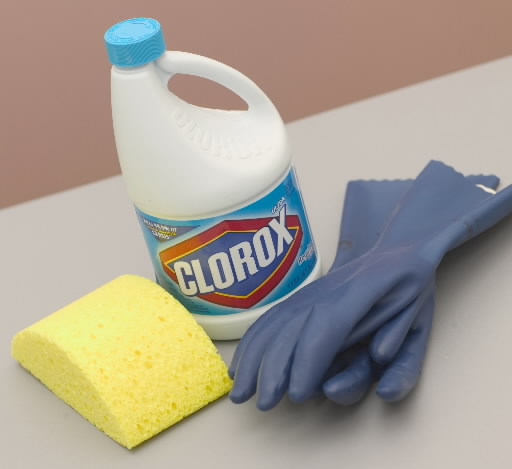
Of all the chemicals, products, pet-enzyme eliminators, sanitizes, etc. out there, THE ONLY THING FOUND TO KILL PARVOVIRUS IS BLEACH. Use about one part bleach to about 30 parts water on any surface that is colorfast, or where color change is acceptable. If not cleaned, Parvovirus will lose its effectiveness indoors in about one month. Outdoors it can last for up to 7-9 months. If the outside has not been decontaminated with bleach, you also run the risk of reintroducing it again indoors. You may bleach outside surfaces the same way you did inside. One method is to use one of those weed killer bottles that attach to your garden hose. Fill it with bleach and spray away. It will kill your grass, but the grass will re-grow, and if you are planning on introducing a new puppy within the next year, dead grass is much preferred to a dead puppy.
The biggest challenge is indoor “soft” surfaces such as furniture or carpet. If you have taken all necessary precaution outdoors, then your chance of re-introduction from your own yard will be significantly diminished and waiting the recommended one month should be sufficient. Another solution for carpet is to add bleach to a carpet cleaner and just not use hot water (as the hot water activates the “whitening power” of the bleach. However, no guarantees that it will still NOT ruin your carpet, so testing on a small, discrete area is recommended first.
REMEMBER:
Urgency is of the utmost importance when dealing with Canine Parvovirus. If there is ANY possibility that it is parvo, (vomiting, lethargic, or especially blood in the stool) the puppy must be taken to the vet or animal hospital IMMEDIATELY! According to the American Veterinary Medical Association: “most deaths from parvovirus occur within 48 to 72 hours.“
Parvovirus must be taken seriously! It is widely known as the number one killer in the world of puppies. As quoted by The North American Llewellin Breeder Association (NALBA):
“Parvo-virus is the number one killer of small puppies. The signs are listlessness, blood in the stool and then the next day bloody stool that looks like someone emptied a bottle of ketchup in the run. By then, it’s too late.”
If in doubt, ANYTIME you see any blood in the stool, and especially if it is associated with lethargy in your puppy, IMMEDIATELY take your puppy to the vet and request a Snap Parvo Test to be completed. Do NOT get a fecal float alone. Fecal floats can take 2-3 days to com back and if your puppy does have Parvo, he will likely be dead before you get the results. It is better to be out $50 or so for the test than to have lost your best friend.





